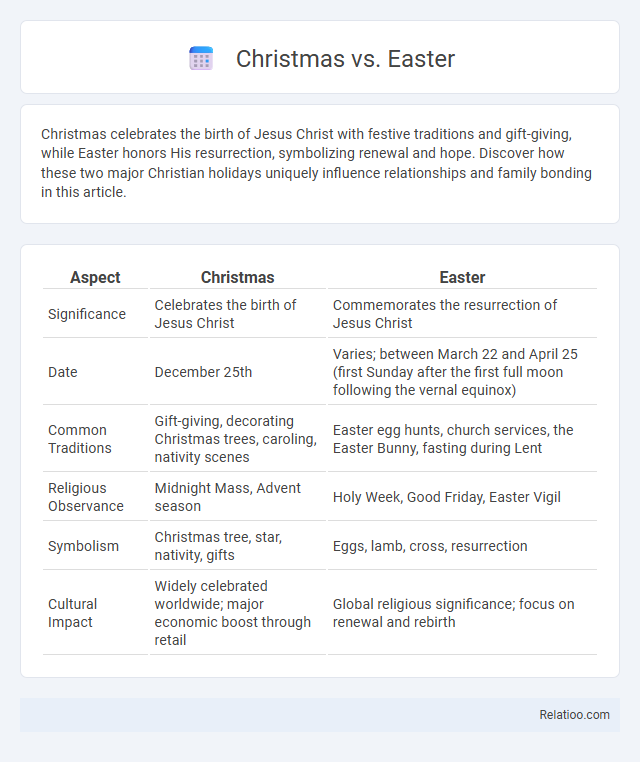Christmas celebrates the birth of Jesus Christ with festive traditions and gift-giving, while Easter honors His resurrection, symbolizing renewal and hope. Discover how these two major Christian holidays uniquely influence relationships and family bonding in this article.
Table of Comparison
| Aspect | Christmas | Easter |
|---|---|---|
| Significance | Celebrates the birth of Jesus Christ | Commemorates the resurrection of Jesus Christ |
| Date | December 25th | Varies; between March 22 and April 25 (first Sunday after the first full moon following the vernal equinox) |
| Common Traditions | Gift-giving, decorating Christmas trees, caroling, nativity scenes | Easter egg hunts, church services, the Easter Bunny, fasting during Lent |
| Religious Observance | Midnight Mass, Advent season | Holy Week, Good Friday, Easter Vigil |
| Symbolism | Christmas tree, star, nativity, gifts | Eggs, lamb, cross, resurrection |
| Cultural Impact | Widely celebrated worldwide; major economic boost through retail | Global religious significance; focus on renewal and rebirth |
Historical Origins of Christmas and Easter
Christmas traces its origins to ancient Roman celebrations like Saturnalia and the Christian commemoration of Jesus Christ's birth on December 25th, symbolizing light during the winter solstice. Easter, rooted in Jewish Passover traditions, celebrates the resurrection of Jesus Christ, marking the cornerstone of Christian faith and typically observed in spring. The dates of both holidays vary, with Christmas fixed on December 25th and Easter determined by the first Sunday after the full moon following the vernal equinox.
Religious Significance: Comparing Christmas and Easter
Christmas celebrates the birth of Jesus Christ, marking the incarnation of God in Christian theology, symbolizing hope and salvation. Easter commemorates the resurrection of Jesus, emphasizing victory over sin and eternal life, central to Christian faith and doctrine. Both holidays hold profound religious significance, with Christmas focusing on the nativity and Easter highlighting the core belief in resurrection and redemption.
Key Symbols and Traditions
Christmas centers on the birth of Jesus Christ, symbolized by the nativity scene, Christmas tree, and gift-giving traditions that celebrate joy and generosity. Easter highlights the resurrection of Jesus, with symbols like the cross, Easter eggs, and the Easter bunny representing new life and rebirth. Your participation in these holidays involves distinct customs: Christmas often includes decorating and sharing meals, while Easter focuses on church services, egg hunts, and celebrating renewal.
Cultural Celebrations Around the World
Christmas celebrates the birth of Jesus and is marked by traditions such as gift-giving, decorations, and festive meals across many cultures worldwide. Easter, commemorating the resurrection of Jesus, features varied customs like egg hunts, church services, and feasts that differ widely by region. Your experience of these holidays is shaped by local customs and the diverse global ways communities honor these significant religious dates.
Popular Foods and Festive Dishes
Christmas features popular dishes like roasted turkey, glazed ham, and gingerbread cookies, symbolizing warmth and tradition. Easter highlights lamb, hot cross buns, and chocolate eggs, reflecting renewal and festivity. Date celebrations emphasize sweet treats such as stuffed dates, date cakes, and syrup-soaked desserts, showcasing regional flavors and cultural significance.
Gift-Giving and Holiday Customs
Christmas gifts often include personalized items and festive wrapping, enhancing the spirit of giving during this widely celebrated December holiday known for its religious and secular customs. Easter gifts frequently consist of chocolate eggs, baskets, and small toys, reflecting traditions centered around renewal and springtime celebrations typically observed in March or April. You can distinguish these holidays by their differing gift-giving practices and cultural rituals, with Christmas emphasizing generosity and family gatherings, while Easter focuses on symbolic gifts and outdoor activities like egg hunts.
Public Perceptions and Modern Adaptations
Christmas is widely perceived as a major cultural and commercial holiday marked by gift-giving, decorations, and family gatherings, often blending religious and secular traditions. Easter retains strong religious significance tied to resurrection themes, yet modern adaptations include popular customs such as egg hunts and chocolate bunnies that appeal to broader audiences. Your choice of celebration often reflects personal beliefs and societal trends, with both holidays evolving to incorporate contemporary values and social practices.
Family Activities and Community Events
Christmas and Easter offer unique family activities and community events that enrich your holiday experience with meaningful traditions. Christmas features festive gatherings, gift exchanges, and community caroling that strengthen family bonds and communal spirit. Easter highlights egg hunts, church services, and spring festivals that encourage outdoor participation and shared celebration.
Economic Impact: Spending During Christmas and Easter
Christmas generates significantly higher economic impact compared to Easter, with U.S. holiday retail sales exceeding $900 billion annually, driven by gift purchases, decorations, and festive events. Easter spending, while notable, centers mostly on food, candy, and seasonal items, contributing approximately $19 billion to the economy each year. Understanding the spending patterns during these holidays can help you optimize business strategies and capitalize on consumer demand peaks.
Lasting Influence on Art, Music, and Literature
Christmas has inspired timeless works such as Charles Dickens' "A Christmas Carol" and Handel's "Messiah," embedding themes of goodwill and redemption into Western culture. Easter's artistic and musical influence is profound, with masterpieces like Michelangelo's "The Resurrection" and Bach's "St. Matthew Passion" reflecting themes of sacrifice and renewal. The differing dates of these holidays have shaped seasonal artistic expressions, with Christmas emphasizing winter motifs and Easter highlighting themes aligned with spring and rebirth.

Infographic: Christmas vs Easter
 relatioo.com
relatioo.com